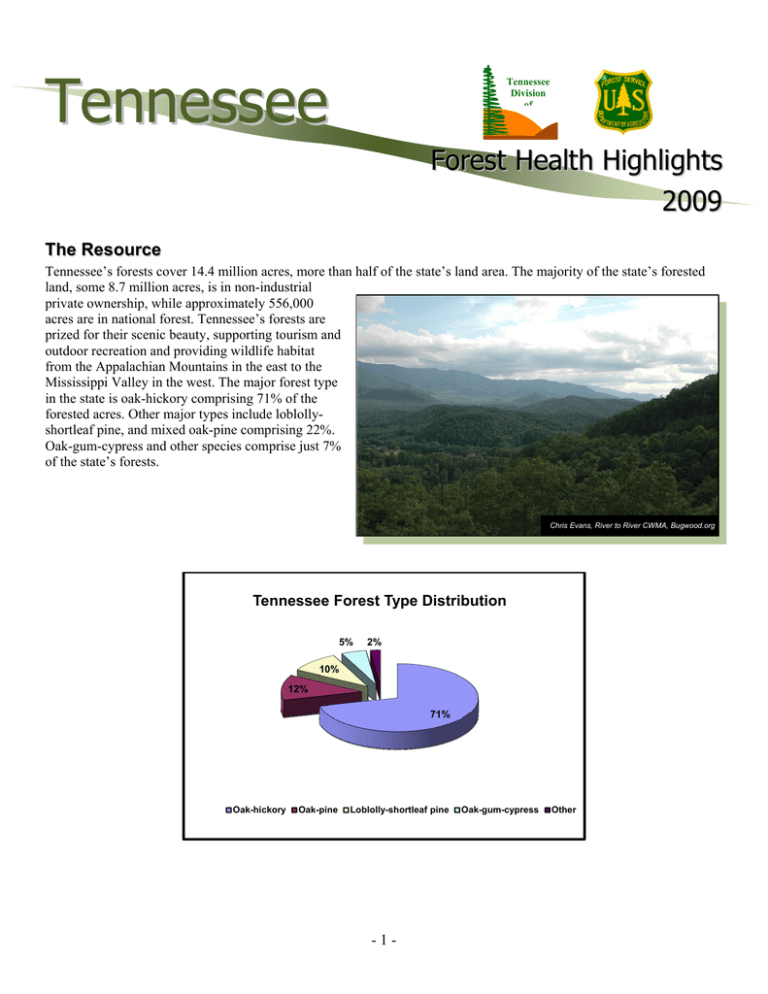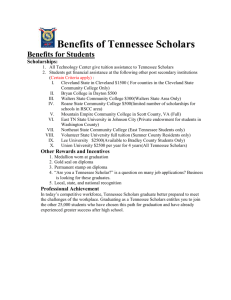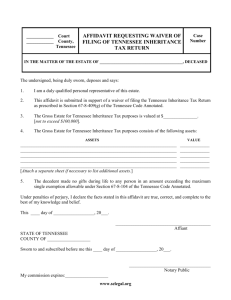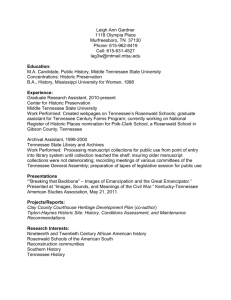T e n s
advertisement

T e nne s s e e Tennessee Division of Forest Health Highlights 2009 The Resource Tennessee’s forests cover 14.4 million acres, more than half of the state’s land area. The majority of the state’s forested land, some 8.7 million acres, is in non-industrial private ownership, while approximately 556,000 acres are in national forest. Tennessee’s forests are prized for their scenic beauty, supporting tourism and outdoor recreation and providing wildlife habitat from the Appalachian Mountains in the east to the Mississippi Valley in the west. The major forest type in the state is oak-hickory comprising 71% of the forested acres. Other major types include loblollyshortleaf pine, and mixed oak-pine comprising 22%. Oak-gum-cypress and other species comprise just 7% of the state’s forests. Chris Evans, River to River CWMA, Bugwood.org Tennessee Forest Type Distribution 5% 2% 10% 12% 71% Oak-hickory Oak-pine Loblolly-shortleaf pine -1- Oak-gum-cypress Other Forest Influences and Programs Southern pine beetle (SPB) is Tennessee’s most significant forest insect pest. In 2009, SPB activity remained at low levels, with no counties in outbreak status and no counties reporting SPB activity. The state conducts pheromone surveys during the early spring to predict SPB activity for the remainder of the year. The state had for several years offered costshare incentives to landowners to perform restoration work and thinning as part of the SPB Prevention Program. Hemlock woolly adelgid is now established in East Tennessee and is spreading toward Middle Tennessee. This small introduced insect has begun to devastate the state’s hemlock resource with extensive mortality in East Tennessee. HWA now infests 27 out of the 40 counties in Tennessee with native hemlock stands. Biological control efforts using several species of predator beetles on federal and state lands have been occurring for at least five years. Hemlock woolly adelgid Connecticut Agricultural Experiment Station Archive, Bugwood.org Gypsy moth is a threat to Tennessee’s hardwood-dominated forests. The state works closely with USDA APHIS-PPQ and the Forest Service to monitor and quickly identify any accidental introductions of the moth; there have been several successful eradication projects covering as much as 40,000 acres in recent years. In 2009, delimiting and mass trapping efforts were conducted in two locations in Claiborne County. No moths were trapped in this infested area for the second year; it is therefore considered to be eradicated. An infestation was detected in Bradley County in east Tennessee by delimiting trapping and egg mass surveying. Other sites of interest are in Roane and Johnson Counties due to high numbers of moths detected. Oak decline impacts timber and recreation resources in Tennessee. It results in dieback and mortality of large, mature oaks. A complex of factors such as drought, frost, insect defoliation, and secondary agents including root and canker diseases and wood boring insects contribute to the condition. Forest surveys indicate that nearly 9% (738,000 acres) of oak forest is susceptible. Oak decline was on the rise during 2009 due to the effect of several consecutive years of drought as seen by the increases in incidence of Hypoxylon canker and oak crown dieback and mortality. Although the drought ended this year the residual effects are still being seen. Storm damage: Ice storm damage occurred on January 27, 2009 causing only light damage to timber in a small portion of Obion and Lake Counties. A tornado occurred on April 10, 2009 causing heavy damage in urban areas of Rutherford County but limited damage in forested areas. Tornado damage, Stones River National Military Park, Rutherford County, TN Div. of Forestry photo -2- Emerald ash borer (EAB) surveys were initiated in 2005 and continued through 2009 under the National Survey Program. USDA APHIS-PPQ and the Tennessee Department of Agriculture are the major survey participants in Tennessee. The survey employs panel traps with lure installed on ash trees in and around campgrounds in Middle Tennessee as well as selected sites in West and East Tennessee. Firewood publicity blitzes have also been conducted near Bristol during significant NASCAR events to educate the public about the potential hazards of moving potentially pest infested firewood from one part of the country to another. As of December 2009, no EAB infestations have been detected in Tennessee. Sudden oak death (SOD) surveys were initiated in 2003 and continued through 2009. Surveys initially focused on the perimeters of horticultural nurseries that received potentially infected plant stock from shippers in California. SOD surveys now focus on more comprehensive stream baiting projects involving watersheds containing several nurseries that may receive potentially infected plant stock. To date no infected sites have been identified by these surveys in Tennessee. Stream baiting will continue in Middle and East Tennessee during 2010. Forest Health Assistance in Tennessee Tennessee Department of Agriculture Division of Forestry P.O. Box 40627 Nashville, TN 37204-0627 615-837-5176 clint.strohmeier@tn.gov http://www.state.tn.us/agriculture/forestry/index.html -3- USDA Forest Service Southern Region, State & Private Forestry Forest Health Protection 200 W.T. Weaver Road Asheville, NC 28804 828-257-4320 http://www.fs.fed.us/r8/foresthealth/








